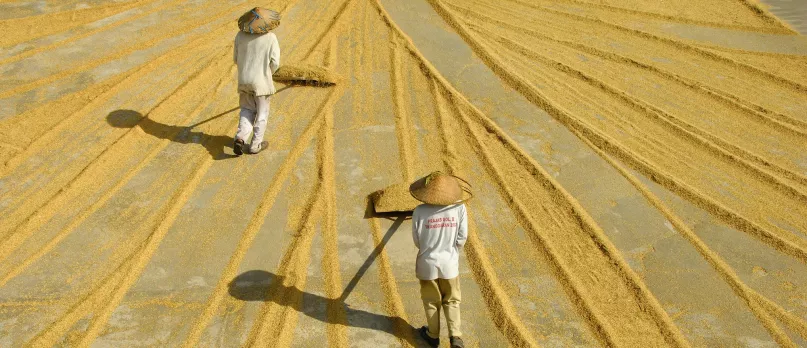Four Strategies for Overcoming Barriers to Agricultural Financing

For years there has been much talk about the need for formal financial service providers (FSPs) to engage in the agriculture sector. We know that farmers and agricultural small and medium enterprises (SMEs) are often excluded from financial services offered by banks, microfinance institutions (MFIs), credit unions, and other regulated financial service providers (FSPs). According to Dahlberg estimates, less than 2% of the demand for global financing by smallholder farmers is met by financial institutions.
We now also have a good understanding of why this is the case, thanks to an abundance of research on the topic. There are a number of risks that are specific to agriculture, including natural disasters, price volatility, pests and disease, which are difficult to mitigate and insure against. In addition, the lack of coordination within value chains, and the bulky, seasonal and long-term financing requirements for food products pose serious challenges. Adding to these challenges is the general lack of capacity within financial institutions to properly assess returns on investment in agricultural activities.
So, should financial service providers care about agriculture? Are there any strategies and interventions that could make the provision of financial services to rural populations both possible and profitable? The answer to both questions is yes. The growing global demand for food is providing more opportunities for investments. This demand is expected to keep growing due to population growth, longer life expectancy, growing urbanization rates, and changing diets made possible by rising income. Global agricultural production is also increasing to meet this demand. For example, between 2004 and 2014 in Africa the production of cereals increased by 69%, roots and tubers by 62%, and fruits by 47%.
Some financial service providers are starting to see the agriculture sector as an opportunity for growth, but others continue to face serious challenges. In recent years, an increasing –yet still small– number of financial institutions have pioneered innovative experiences related to the delivery of a wide range of agricultural financial products and other investment vehicles, which tend to be more inclusive of poorer rural families that depend on agriculture.

Drawing from the common traits of such experiences, four key strategies for addressing bottlenecks and overcoming barriers emerge:
- Improve financial institutions’ understanding of the agricultural markets and their capacity to assess business opportunities. This implies a shift towards a value chain approach, which considers the collective set of actors and processes over the entire value chain when making financing decisions. This approach would allow financial institutions to acquire knowledge from input providers, traders, processors, wholesalers and other value chain actors as well as informal service providers who hold a unique informational advantage due to their direct business engagement within the value chain. Financial institutions can also take advantage of the current unprecedented availability of quantitative data to form market intelligence for agricultural finance, which enables significant cost savings before moving to the qualitative analysis of product design.
- Diversify and adapt products and services for different actors of the value chain. This strategy, which follows on the previous one, requires a learning process by the financial institutions in order to identify additional client needs and capacities, and opportunities to offer additional services. This process also implies developing partnerships with other local actors, and better and cheaper ways to deliver a growing number of services. Each additional financial service offered in rural areas can bring increasing returns, facilitating the profitability of the rural portfolio.
- Establish strategic partnerships with non-financial service providers, for transferring non-financial costs to specialized entities. Non-financial costs are mostly related to the technical assistance needed to strengthen the organization and coordination among several actors in the value chain. It includes capacity-building for farmers, cooperatives, and SMEs in different areas such as governance, financial management, and marketing. Such partnerships open the door to win-win collaboration: financial institutions offer needed agricultural finance, and the public sector addresses complementary development objectives. The public sector can play a leading role in creating an enabling environment for agricultural investments and new market opportunities for private investors.
- Identify alternatives to guarantees based on physical collateral. Due to farmers’ frequent lack of collateral, financial institutions tend to reject their business proposals regardless of the potential return on investment. Integrating farmers into the financial system will require innovations not only in products but also in processes. Some successful experiences have shown that an effective way to reduce risks is to identify processes and indicators that give relatively minor weight to guarantees, focusing instead on performance indicators. New processes based on alternatives to collateral-based lending can also help reduce the time needed for approval and disbursement of loans, without restricting appraisal capacity.
If we are to meet the rising demand for food from the world’s growing population, these strategies – and more – will become increasingly necessary to provide the financing needed for the world’s farmers.
 The Microfinance Gateway is proud to be an outreach partner for African Microfinance Week 2017, with the theme of Creating Values for SMEs: A New Key Role for Microfinance?
The Microfinance Gateway is proud to be an outreach partner for African Microfinance Week 2017, with the theme of Creating Values for SMEs: A New Key Role for Microfinance?



I would love you to go deeper into the solution to lack of funds
Leave a comment